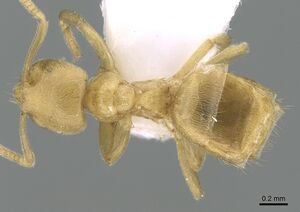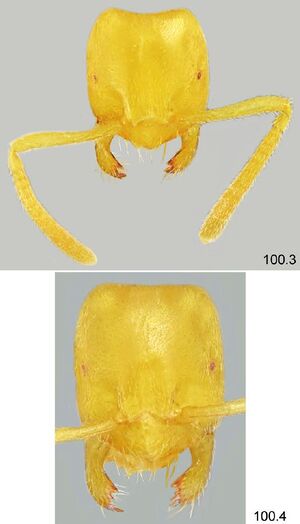Metalasius myrmidon
| Metalasius myrmidon | |
|---|---|

| |
| Scientific classification | |
| Kingdom: | Animalia |
| Phylum: | Arthropoda |
| Class: | Insecta |
| Order: | Hymenoptera |
| Family: | Formicidae |
| Subfamily: | Formicinae |
| Tribe: | Lasiini |
| Genus: | Metalasius |
| Species: | M. myrmidon |
| Binomial name | |
| Metalasius myrmidon (Mei, 1998) | |
Endemic to Greece, Metalasius myrmidon nests under small stoned. It is quite rare and occurs in forest habitats.
Identification
Definition (worker) (Boudinot et al., 2022).
- With character states of Metalasius.
- Dorsal mandibular groove absent (see Boudinot et al. (2022), Note 1).
- Ventromedial base of mandible without trough or impression (see Boudinot et al. (2022), Note 2).
- Maxillary palps short, exceeding hypostomal margin but not reaching postgenal bridge midlength.
- Maxillary palpomere 3 longest, 4 shorter but as long as 5 and 6 together (see Boudinot et al. (2022), Note 3).
- Clypeus, in lateral view, convex and weakly bulging anteriorly (see Boudinot et al. (2022), Note 3).
- Anterior tentorial pit situated lateral to midlength of the epistomal suture.
- Lateral hypostomal carina absent (see Boudinot et al. (2022), Note 4).
- Compound eyes absent, reduced or vestigial, with at most 9 ommatidia (see Boudinot et al. (2022), Note 5).
- Propodeal spiracle situated distinctly in lower half of propodeum (see Boudinot et al. (2022), Note 6).
- Legs almost entirely devoid of standing setae (see Boudinot et al. (2022), Note 3).
- Petiolar node weakly inclined anteriorly, node well-developed, squamiform (see Boudinot et al. (2022), Note 7).
Metalasius myrmidon is uniquely identified among the Lasiini by:
- absence of the dorsal mandibular groove and lateral hypostomal carina
- short and broad third antennomere
- mid-set compound eyes (when present), which are reduced to at most 9 ommatidia
- near complete absence of standing setae on the head.
Note that high magnification may be required to evaluate the lateral hypostoma.
Keys including this Species
Distribution
Latitudinal Distribution Pattern
Latitudinal Range: 39.94444444° to 38°.
| North Temperate |
North Subtropical |
Tropical | South Subtropical |
South Temperate |
- Source: AntMaps
Distribution based on Regional Taxon Lists
Palaearctic Region: Greece (type locality).
Distribution based on AntMaps
Distribution based on AntWeb specimens
Check data from AntWeb
Habitat
Borowiec and Salata (2022), for Greece - Very rare species noted from oak forests, mixed forest and pine forest. All collecting sites were from mid altitude between 540 and 600 m.
Biology
Castes
Worker
Images from AntWeb
   
| |
| Worker. Specimen code casent0906115. Photographer Estella Ortega, uploaded by California Academy of Sciences. | Owned by CAS, San Francisco, CA, USA. |
Nomenclature
The following information is derived from Barry Bolton's Online Catalogue of the Ants of the World.
- myrmidon. Lasius myrmidon Mei, 1998: 177, figs. 1-11 (w.) GREECE.
- Combination in Metalasius: Boudinot et al., 2022: 140.
Unless otherwise noted the text for the remainder of this section is reported from the publication that includes the original description.
Description
Worker
Borowiec and Salata (2022) - Slightly polymorphic, HL 0.571-0.619, HW 0.500-0.524, ML 0.59-0.64. Scape moderately elongate, SL 0.460-0.492. Color. Whole body including appendages pale yellow. Structure and setation. Head 1.1-1.2 times longer than wide, almost parallelsided or with slightly rounded sides, occipital margin shallowly concave. Eyes rudimental. Whole frontal head covered with moderately long and moderately dense pubescence, erected setae absent. Occipital part of head lacking erected setae, only with some subdecumbent hair. Gena and underside of head lacking erected setae. Mesosomal and promesosomal dorsum with several long erected setae, length of the longest seta 0.079, propodeum lacking erected setae. Below propodeal spiracle single seta. Masticatory border of mandibles with 5-6 teeth. Antennal scapi with short appressed and slightly decumbent pubescence, erected setae absent butapically with suberect hair. Hind tibiae lacking erected setae on external surface. Ventral surface of femora lacking erected setae, anterior surface of fore coxa with two long erected setae. Pubescence on the whole body and appendages very dense and whitish. Pubescence of clypeus very sparse, not covering Clypeus. Surface of gastral tergites with microsculpture but shiny, first gastral tergite in central part with sparse, long erected setae. Propodeum in lateral view low to moderately high, obtuse, metanotal groove moderately deep.
References
- Borowiec, L. 2014. Catalogue of ants of Europe, the Mediterranean Basin and adjacent regions (Hymenoptera: Formicidae). Genus (Wroclaw) 25(1-2): 1-340.
- Borowiec, L. & Salata, S. 2013. Ants of Greece – additions and corrections (Hymenoptera Formicidae). Genus (Wroclaw) 24, 335-401.
- Borowiec, L., Salata, S. 2022. A monographic review of ants of Greece (Hymenoptera: Formicidae). Vol. 1. Introduction and review of all subfamilies except the subfamily Myrmicinae. Part 1: text. Natural History Monographs of the Upper Silesian Museum 1: 1-297.
- Boudinot, B.E., Borowiec, M.L., Prebus, M.M. 2022. Phylogeny, evolution, and classification of the ant genus Lasius, the tribe Lasiini and the subfamily Formicinae (Hymenoptera: Formicidae). Systematic Entomology 47, 113-151 (doi:10.1111/syen.12522).
- Mei, M. 1998. Lasius (Cautolasius) myrmidon n. sp.: a new hypogaeic ant from Greece (Hymenoptera Formicidae). Boll. Soc. Entomol. Ital. 130: 177-182 (page 177, figs. 1-11 worker described)
References based on Global Ant Biodiversity Informatics
- Borowiec L. 2014. Catalogue of ants of Europe, the Mediterranean Basin and adjacent regions (Hymenoptera: Formicidae). Genus (Wroclaw) 25(1-2): 1-340.
- Borowiec L., and S. Salata. 2012. Ants of Greece - Checklist, comments and new faunistic data (Hymenoptera: Formicidae). Genus 23(4): 461-563.
- Borowiec L., and S. Salata. 2017. Ants of the Peloponnese, Greece (Hymenoptera: Formicidae). Polish Journal of Entomology 86: 193-236.
- Czechowski W., A. Radchenko, W. Czechowska and K. Vepsäläinen. 2012. The ants of Poland with reference to the myrmecofauna of Europe. Fauna Poloniae 4. Warsaw: Natura Optima Dux Foundation, 1-496 pp
- Mei, M.. "Lasius (Cautolasius) myrmidon n. sp.: A new hypogaeic ant from Greece (Hymenoptera, Formicidae)." Bollettino della Societa Entomologica Italiana 130 (1998): 177-182.



